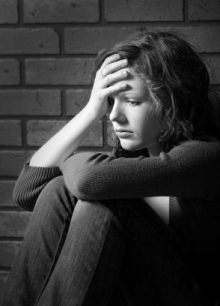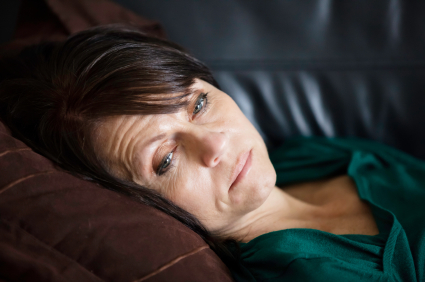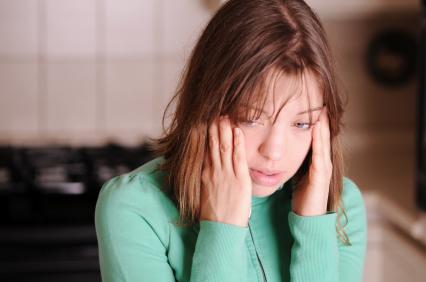ᔥSubstance Abuse and Mental Health Administration (SAMHSA)

A new report shows that the percentage of girls who experience a major depressive episode in the past year triples between the ages of 12 and 15 (from 5.1 percent to 15.2 percent respectively). The report by the Substance Abuse and Mental Health Services Administration (SAMHSA) also shows that an annual average of 1.4 million adolescent girls age 12 to 17 experienced a major depressive episode in the past year. In addition, the report reveals that adolescent girls aged 12 to 17 are three times more likely to have experienced a major depressive episode in the past year than their male counterparts (12 percent versus 4.5 percent).
A major depressive episode is defined using criteria set forth in the Diagnostic and Statistical Manual of Mental Disorders (DSM-IV) developed by the American Psychiatric Association. Under this definition, a major depressive episode is when a person experiences a period of depressed mood or loss of interest or pleasure for two weeks or longer and also experiences at least four other symptoms that reflect a change in functioning, such as problems with sleep, eating, energy, concentration and self-image.
“It is crucial that we provide adolescent girls the coping skills and social supports they need to avoid the onset of depression, and to offer behavioral health services that foster resilience and recovery if they experience it,” said SAMHSA Administrator Pamela S. Hyde. “These efforts are a sound investment in girls’ health and well-being and in our nation’s future.” [continue reading…]
Depression

Two separate studies show that clinical anxiety and depression are serious health issues all around the world
© iStockphoto
Depression and anxiety are found in every society in the world, debunking old theories that only Westerners get depressed.
These new findings come from the world’s most comprehensive study of anxiety and depression research to date, published by researchers at The University of Queensland.
In two separate studies of anxiety disorders and major depressive disorder (that is, clinical depression) study authors found that surveys of clinical anxiety and depression have been conducted across 91 countries, involving more than 480,000 people.
They show that clinical anxiety and depression are serious health issues all around the world. [continue reading…]

© iStockphoto
Compared to nonanxious depressed patients, anxious depressed patients respond less to pharmacotherapy, prompting consideration of alternate treatments. Based on the transdiagnostic principles of cognitive therapy (CT), a group of investigators predicted that anxious depressed patients would respond as well to CT as nonanxious depressed patients. Adults (n = 523) with recurrent major depressive disorder received 12–14 weeks of CT as part of the Continuation Phase Cognitive Therapy Relapse Prevention Trial. Anxious depressed patients (n=264; 50.4%) were compared to nonanxious depressed patients (n = 259; 49.6%) on demographic variables, initial severity, attrition, and rates and patterns of response and remission.
Anxious depressed patients presented with greater illness severity and had significantly lower response (55.3 vs. 68.3%) and remission rates (26.9 vs. 40.2%) based on clinician-administered measures. By contrast, smaller between-group differences for attrition, and for response (59.1 vs. 64.9%) and remission (41.7 vs. 48.7%) rates on self-report measures were not significant. Further, anxious depressed patients had greater speed of improvement on self-reported anxiety symptom severity and clinician-rated depressive and anxiety symptom severity measures. Consistent with prior reports, anxious depressed patients presented with greater severity and, following CT, had lower response and remission rates on clinician-administered scales. However, anxious depressed patients improved more rapidly and response and remission rates on self-report measures were not significantly different from nonanxious depressed patients. These findings suggest that anxious depressed patients may simply need additional time or more CT sessions to reach outcomes fully comparable to those of less anxious patients.
ᔥPsychotherapy and Psychosomatics
Full bibliographic information
Smits, J.A.J. ; Minhajuddin, A. ; Thase, M.E. ; Jarrett, R.B. Outcomes of Acute Phase Cognitive Therapy in Outpatients with Anxious versus Nonanxious Depression. Psychother Psychosom 2012;81:153-160
Treating adolescents for major depression can also reduce their chances of abusing drugs later on, a secondary benefit found in a five-year study of nearly 200 youths at 11 sites across the United States.
Only 10 percent of 192 adolescents whose depression receded after 12 weeks of treatment later abused drugs, compared to 25 percent of those for whom treatment did not work, according to research led by John Curry, a professor of psychology and neuroscience at Duke University.
“It turned out that whatever they responded to — cognitive behavioral therapy, Prozac, both treatments, or a placebo — if they did respond within 12 weeks they were less likely to develop a drug-use disorder,” Curry said.
The study found no such relationship when it came to thwarting alcohol abuse, however.
The researchers followed nearly half the 439 participants from the “Treatment for Adolescents with Depression Study” (TADS; 2000-2003), led by Dr. John March, chief of Child and Adolescent Psychiatry at Duke University Medical Center. TADS is considered the largest sample of adolescents who had been treated for major depression. (https://trialweb.dcri.duke.edu/tads/overview.html)
The participants analyzed by Curry’s study were ages 17-23 at the end of the five-year follow-up study and had no preexisting problems with abusing alcohol or drugs.
[continue reading…]
